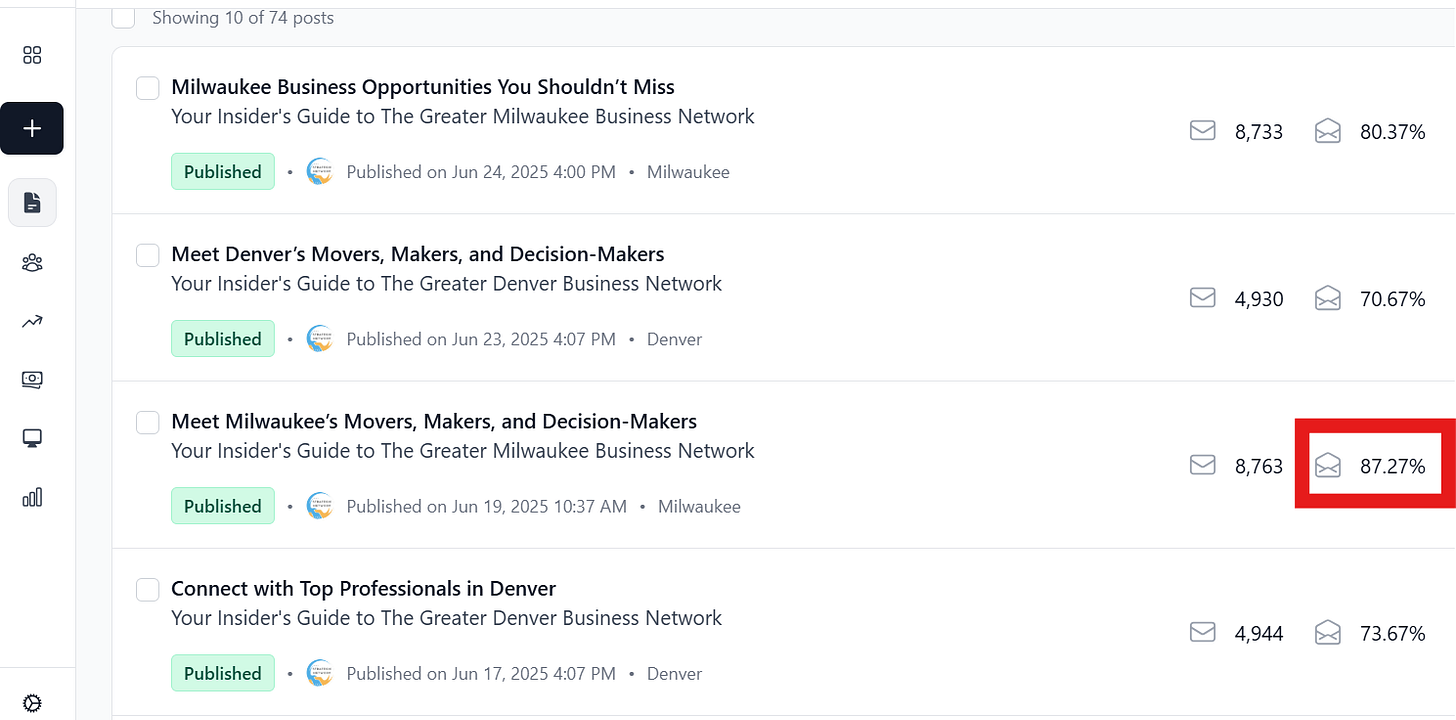My Quest for a 90% Open Rate
For the longest time, I was obsessed with getting high open rates for my newsletters. But do they even matter anymore?
Open rates have long been a foundational metric in email marketing. They were used to measure how many recipients opened an email after it was delivered.
Introduced alongside early email tracking tools, open rates relied on a small, invisible tracking pixel embedded in the email that were triggered when a recipient opened the message and allowed images to load.
Here’s how an open rate is calculated:
Open Rate = (Unique Opens ÷ Emails Delivered) × 100
For example:
If you send 1,000 emails and 500 are opened, your open rate is 50%.
For years, marketers treated open rates as a key indicator of subject line effectiveness, audience interest, and overall campaign health.
When I first started publishing local newsletters a while back, I noticed my open rates steadily climbing.
31% … 37% … 45% … 52% … 60% … 73% …
Open rates became a key metric that I tracked relentlessly.
I found myself checking open rates like many people check their LinkedIn or Instagram accounts.
Why?
I figured if enough people were opening my emails, they had to be good.
But over time, as I observed my open rates approaching 80 - 90%, I realized it was more of a vanity metric than a sign of success.
So what happened?
⚠️ Open Rates Became Less Reliable
Open rates are less reliable now for several key reasons that are mostly tied to changes in technology and privacy policies:
Privacy changes - Apple’s Mail Privacy Protection (and similar moves by others) inflate open rates even if no human sees it. MPP automatically preloads email content (including tracking pixels), which can falsely register an "open" even if the user never read the email.
Blocking - Some email providers now block or strip tracking pixels used to detect opens.
Forwarding - Forwarded emails, shared inboxes, or multiple devices can all trigger multiple opens from a single user, further muddying the data.
Bot activity - Security scanners and bots can register as “opens.”
🔄 Better Metrics Are Now Available
Instead of open rates, many email marketers now focus more on:
Click-through rate (CTR) - Who engages with your content
Conversions - Signups, meetings booked, downloads, purchases, etc.
Reply rate - Especially for B2B or community-focused newsletters.
Engaged segments - Measure who opens and clicks over time.
Subscriber retention/churn - How well you're keeping your audience over time
So, is it time to stop caring about open rates?
Are open rates officially dead?
📌 Why Open Rates Still Matter
Despite growing limitations from privacy protections like Apple Mail Privacy Protection, open rates still offer value. For example, they still provide:
First signal of interest - The open rate is the first indicator that your subject line, sender name, and timing are effective.
Relative comparisons - Even if absolute numbers are fuzzy, comparing open rates across campaigns still helps identify trends (e.g., best days, formats, or topics).
List health indicator - A sudden drop might signal deliverability issues or list fatigue.
Open rates can help you spot trends over time, compare subject line performance, and gauge audience interest at a high level.
While no longer a perfectly accurate metric, open rates remain a useful directional signal, especially when paired with other data points like clicks, replies, and conversions.
Open rates may be flawed, but they’re far from useless.
👍 Optimizing Open Rates
Open rates may not tell the full story, but they’re still the first signal that your message is reaching its audience.
Here are some effective ways to boost your open rates:
1. Craft irresistible subject lines - This is your first impression so it has to earn the open.
Use curiosity, relevance, or urgency:
“Who's hiring in St. Louis this month?” or “This local lead could change your year.”Personalize when possible:
“Mike, your Boston network is growing fast”Test formats regularly:
Emojis, questions, lists, cliffhangers, or power words (e.g. “Unlock,” “Proven,” “Revealed”)
A/B test subject lines weekly. Even small tweaks = big gains.
2. Build a habit with consistent send times - People open what they expect, so consistency builds trust.
Send on the same day and time each week (e.g., Tuesday @ 9:30 AM)
Over time, your audience anticipates the email and is more likely to open it
Look at your own data: Some audiences prefer weekend or evening reads
3. Use a recognizable & trusted sender name - Your sender name often matters more than the subject line.
Use a human name or brand + human combo
“Mike at Local Connect” > “Local Connect Newsletter”Never switch sender names randomly
Keep it consistent across all emails unless you're running a specific campaign
4. Segment & target your audience - The more relevant the email, the more likely it gets opened.
Segment by location, interest, role, or behavior. For example, separate emails for “Boston tech professionals” vs. “DC job seekers”
Suppress unengaged subscribers after 60–90 days
Send “winback” emails to re-engage before dropping them
5. Optimize preheader text - This line supports the subject line, so don’t waste it.
Give a reason to open: “Meet 3 networkers hiring in your area”
Avoid generic filler like “View this in your browser”
Think of it as your second subject line
✅ The Takeaway
Open rates still matter, but treat them as a directional metric and not an ultimate goal.
Since opens don’t always translate to clicks, conversions, or revenue, smart email marketers now focus on a variety of metrics and emerging trends over time.
Rather than obsessing over one number, look at changes across weeks and months.
Notice any trends or shifts?
Adjust your approach accordingly to maximize results.
Have a great week!
- Mike
👀 WHERE TO FIND ME
Facebook: https://www.facebook.com/tipclub
Instagram: https://www.instagram.com/tipclub.inc/
Threads: https://www.threads.net/@tipclub.inc






Click through rates and number of comments are my top metrics to track.
Likes come somewhat low in my list because I feel we got addicted to click like even when we feel “eh, not bad”.
With how complex of a platform Substack has become, open rates has its place but I’m truly unsure how much it matters to me.